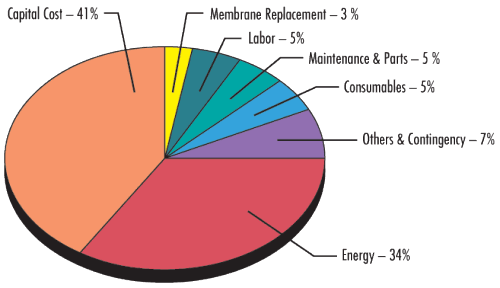Limited water availability has regulators, water management districts and municipalities looking for drought-proof, reliable water supplies. Seawater desalination is a technically viable solution to the water shortages in the United States; however, this technical viability has to be considered along with the water costs associated with the treatment of seawater. Seawater typically has a feed water total dissolved solids (TDS) content of 35,000 mg/L. This translates into a higher feed pressure, as well as more expensive materials of construction for treatment systems.
Some coastal communities have access to lower salinity seawater (15,000 to 25,000 mg/L TDS), due to fresh water contributions from surface run-off or fresh-water surface water bodies. However, lower salinity and /or fluctuations in salinity can result in other challenges. Coastal communities such as the Florida Keys and Tampa Bay have used seawater desalination successfully, and several other coastal communities may soon be considering this alternative water supply. New projects in Carlsbad, CA, and Huntington Beach, CA, are well underway.
Feed Water Supply and Treatment
Selection of a seawater supply source for RO desalination systems depends to some extent on site conditions, but is mainly determined by system size. For large seawater systems the only viable source of seawater supply is from an open intake. The options include either as a stand-alone system or co-located or contiguous to some larger seawater user such as a power plant. Supply from a dedicated intake usually implies a dedicated outfall facility as well. Current regulations require careful design that will minimize any potential environmental effect. The lengthy permitting process for construction and operation of intake and outfall facilities makes location of RO plants adjacent to on shore-located power plants a very convenient solution.
In this process configuration, the RO system uses the seawater discharged from the heat reject section of the power plant before it flows to the ocean. In a similar fashion, RO concentrate is discharged to the same line, downstream of the feed uptake. The temperature of seawater at the outlet from a power plant is usually higher by 3 – 5 C than the water at the intake. For locations with low seawater temperature, the temperature increase is beneficial as it increases membrane permeability, allowing the RO system to operate at lower feed pressure. During periods of high seawater temperature, above 30 C, a further increase of feed water temperature does not result in any significant decrease of feed pressure.
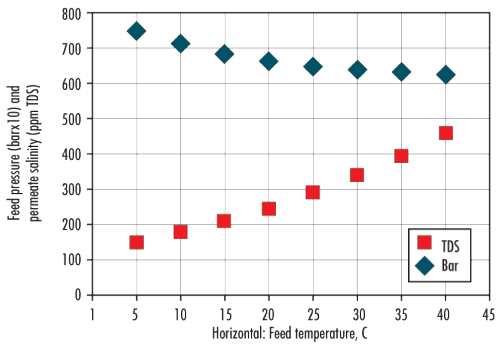 |
| Figure 1: Feed Water Temperature Effect on Feed Pressure and Permeate Salinity in RO Seawater Desalination System |
Depending on feed salinity and recovery rate in the temperature range of 30 – 40 C, higher membrane permeability at higher temperature is adversely compensated by increased osmotic pressure. Higher feed water temperature results in higher salt passage (shown in Figure 1). If this increase of salt passage requires increased operation of the second pass, higher feed water temperature can actually result in higher power consumption of the plant.
Location of the RO system contiguous to a power plant may result in some feed water quality challenges. It is a common practice of power plants to intermittently chlorinate their intake structures to reduce bio-growth. An additional periodic event that may affect seawater quality is cleaning of the heat transfer surfaces of the condenser. As a result of cleaning, small particle fragments are released to the cooling seawater that can end up in the RO feed. Both periodic events at the power plant should be addressed in RO system design and operational review to prevent potential membrane damage.
Use of power plant discharge seawater as a feed to an RO system typically creates design challenges. These are related to the wide fluctuation of feed water temperature resulting from variable load operation of the power plant combined with seasonal temperature fluctuation. Therefore, there is a need for corresponding adjustments of feed pressure to the RO membranes, and the level of utilization of the second pass RO units. At California power plant costal sites such as Huntington Beach and Carlsbad, where desalination RO plants are being developed, feed water temperature swings are projected to reach 16 C (~ 30 F) between winter-conditions low-power-plant load, and the summertime peak load power operation. The corresponding swings of feed water pressure are projected to exceed 10 bar (150 psi). The design team of Tetra Tech and Israel Desalination Engineering (IDE) is currently addressing these projected operating conditions in their design through optimization of pumping and energy recovery system configurations to minimize energy losses in a multi-step pumping system.
When a plant is not co-located with a power plant it is still important to characterize the feed water quality and its fluctuations. Along U.S. coastlines, large fluctuations in salinity should be measured and modeled for seawater RO design. Media filtration and microfiltration/ultrafiltration membrane pre-treatment systems will operate reliably for a wide range of raw water quality, and protect downstream RO membrane treatment units.
Permeate Quality
Current requirements of permeate quality usually include stringent specifications for a number of constituents, including boron. Because boron is poorly rejected by RO membranes at ambient pH, specifications for boron concentration in permeate affects system configuration and the scope of the second pass treatment. A number of process configurations have been proposed to effectively achieve low boron concentration in the permeate of seawater RO systems. A majority of these involve RO treatment of first pass permeate at elevated pH and/or utilization of boron specific ion exchange.
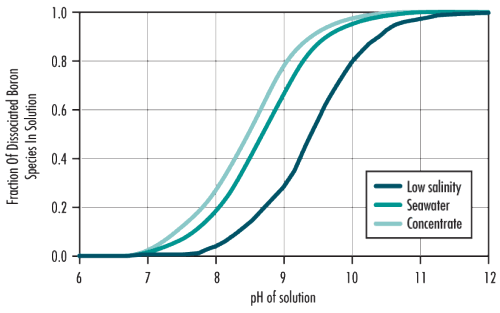 |
| Figure 2: Distribution of Boron Species as a Function of Water Salinity |
Boron rejection by RO membranes is a function of pH, closely following the dissociation ratio of boric acid. Figure 2 shows dissociation ratio of boric acid to borate versus pH. This figure also shows that the dissociation ratio increases with the feed salinity (ionic strength). With increased salinity the equivalent dissociation ratio shifts to lower pH. Accordingly, relatively minor increase of pH of seawater feed will result in significant decrease of boron passage. This approach is being implemented by Tetra Tech for a large seawater desalination facility, where the rate of boron rejection by seawater membranes will be improved by elimination of acidification and some increase of feed pH during periods of high feed water temperature.
Seawater Desalination Costs
In the last few years, RO seawater desalination technology went through a remarkable transformation. The number and capacity of large RO plants have increased significantly. Systems with permeate capacity up to 100 mgd are currently being built and some are already in operation. In a parallel shift the capital and operating cost has decreased. Desalted water cost, supplied to customer, decreased from about $8.0/kgallon ($2600/AF) in 1998 down to current (2004 - 2007) price of about $2.0 – $3.0/kgallon ($650 - $1000/AF). This decrease of water cost is even more remarkable if one considers that, on the average, the current permeate water quality requirements are more stringent now than they were five years ago.
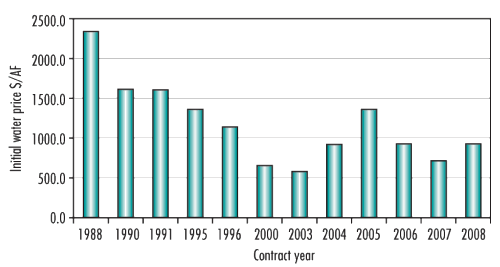 |
| Figure 3: Initial Water Sell Prices in Large Seawater Projects |
The drivers behind these economical improvements are competition and improvement of process and membrane technology. The competitive bidding process has affected prices of every equipment component of RO systems (including membrane elements) and resulted in a broad price decline. Better performance of equipment and optimization of process design resulted in lower operating cost. The recent trend in cost of water from large seawater RO projects is summarized in Figure 3. The graph shows stabilization of water price level below $1000/AF ($3.0/kgallon).
The following technical features characterize recent improvements to the current design philosophy for large seawater RO desalination systems:
1. Utilization of high efficiency pumping and power recovery equipment.
2. Optimization of recovery rate in respect of power consumption.
3. Increased number of elements per pressure vessel.
4. More efficient two pass configuration.
5. Attempts to utilize power plant cooling water as a feed to RO systems.
6. Increasing trend to utilize UF/MF filtration as feed water pretreatment step.
7. Better performance of seawater RO membranes.
Figure 4: Components of Product Water Cost in Seawater RO Desalination System
Water Cost Distribution
The contribution of various components to the cost of product water from a seawater RO system is presented in Figure 4. The largest components are power and fixed charges. Figure 5 shows a breakdown of power consumption. As expected, the high pressure feed pumping system is the major power consumer. The overall power consumption can be reduced by using a more efficient pumping system and by optimizing the recovery rate.
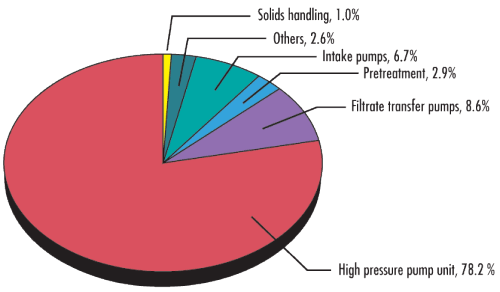 |
| Figure 5: Distribution of Power Consumption in Seawater RO Desalination Systems |
In seawater RO systems the feed pressure required to produce design output capacity fluctuates with feed water salinity, temperature, degree of membrane surface fouling and membrane compaction. Pelton wheels or positive displacement devices can provide sufficient operational flexibility as a power/energy recovery device. The advantage of the Pelton wheel is the flat efficiency curve in a wide range of concentrate flow. However, concentrate exits the Pelton wheel at atmospheric pressure, therefore sufficient gravitation head or additional pumping is required for concentrate disposal.
Summary
The cost of seawater desalination by reverse osmosis has significantly decreased. Both greater competition and improved technology have contributed to this reduction in desalted water price. The main technological improvements have come from the optimized process design and improved equipment. Process developments such as two-pass, split partial permeate treatment, one-stage array configuration, and high pH seawater feed for boron removal have proven to be cost effective. Finally, desalination cost has declined due to higher efficiency energy recovery devices and higher permeability, high rejection membranes. Seawater RO desalination systems still require pilot testing, environmental permitting, and public education to be successful.
About the Authors
Jill Hudkins, PE, is a Vice President and Senior Project Manager for Water Treatment Infrastructure Programs at Tetra Tech. Hudkins holds a Bachelor of Science degree in Civil Engineering from Duke University and a Master of Engineering degree in Civil Engineering from the Massachusetts Institute of Technology. Dr. Mark Wilf has more than 35 years of experience in the membrane process industry. Wilf serves as the National Director of Membrane Technology for Tetra Tech and is a regular contributor to professional journals. Jarrett Kinslow, PE, serves as a Project Manager and Design Engineer for Tetra Tech. He holds a Bachelor of Science in Environmental Engineering from the University of Central Florida.
